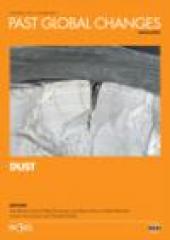- Home
- Publications
- PAGES Magazine
- 22 (2): Dust
22 (2): Dust
Eds: Merkel U, Rousseau D-D, Stuut J-B, Winckler G, von Gunten L & Kiefer T
Past Global Changes Magazine
22(2)
57-116
2014

Number of pages
60
This issue of PAGES Magazine addresses mineral dust, giving an overview of the science the ADOM working group has focused on in recent years. It covers both modern developments and paleo archives and highlights challenges to state-of-the art dust research. It also outlines how PAGES' new dust working group, DICE (Dust Impact on Climate and Environment), plans to build on ADOM's work.
Access individual html and pdf articles further below.
The full magazine is available in the following formats:
> High resolution pdf (52.7 MB)
> Low resolution pdf (6.6 MB)
> Access an interactive PDF via the online publication platform Issuu
Extras
> Full reference list (pdf)
> All figures (pptx)
Individual Articles
Announcements
 > News, Calendar, Featured products [p.58]
> News, Calendar, Featured products [p.58]
 > YSM special issue [p.113]
> YSM special issue [p.113]
Editorial
 > Editorial: Present and past mineral dust variations – a cross-disciplinary challenge for research [p.59-60]
> Editorial: Present and past mineral dust variations – a cross-disciplinary challenge for research [p.59-60]
U. Merkel, D.-D. Rousseau, J.-B.W. Stuut and G. Winckler
Science Highlights
 > Mineral dust: Meteorological controls and climate impacts [p.62-63]
> Mineral dust: Meteorological controls and climate impacts [p.62-63]
K. Schepanski, U. Merkel and I. Tegen
 > Dust deposition rates derived from optical satellite observations [p.64-65]
> Dust deposition rates derived from optical satellite observations [p.64-65]
L. Lelli, W. von Hoyningen-Huene, M. Vountas, M. Jäger and J.P. Burrows
 > Including dust dynamics in paleoclimate modeling [p.66-67]
> Including dust dynamics in paleoclimate modeling [p.66-67]
Y. Shao
 > Characterizing the temporal and spatial variability of African dust over the Atlantic [p.68-69]
> Characterizing the temporal and spatial variability of African dust over the Atlantic [p.68-69]
J.M. Prospero
 > The significance of particle size of long-range transported mineral dust [p.70-71]
> The significance of particle size of long-range transported mineral dust [p.70-71]
J.-B.W. Stuut and M.A. Prins
 > A 10,000 km dust highway between the Taklamakan Desert and Greenland [p.72-73]
> A 10,000 km dust highway between the Taklamakan Desert and Greenland [p.72-73]
A.J.-M. Bory
 > The enigma of dust provenance: where else does Antarctic dust come from? [p.74-75]
> The enigma of dust provenance: where else does Antarctic dust come from? [p.74-75]
P. Vallelonga
 > Evidence that local dust sources supply low-elevation Antarctic regions [p.76-77]
> Evidence that local dust sources supply low-elevation Antarctic regions [p.76-77]
B.G. Koffman and K.J. Kreutz
 > South American dust signature in geological archives of the Southern Hemisphere [p.78-79]
> South American dust signature in geological archives of the Southern Hemisphere [p.78-79]
S. Gili and D.M. Gaiero
 > Fingerprinting aeolian dust in marine sediment: examples from Australia [p.80-81]
> Fingerprinting aeolian dust in marine sediment: examples from Australia [p.80-81]
P. De Deckker
 > Iron fertilization in the glacial ocean [p.82-83]
> Iron fertilization in the glacial ocean [p.82-83]
A. Martínez-García and G. Winckler
 > Loess as a Quaternary paleoenvironmental indicator [p.84-85]
> Loess as a Quaternary paleoenvironmental indicator [p.84-85]
D.R. Muhs, M.A. Prins and B. Machalett
 > Abrupt climate changes recorded in loess sequences [p.86-87]
> Abrupt climate changes recorded in loess sequences [p.86-87]
D.-D. Rousseau and A. Sima
 > Extracting paleodust information from peat geochemistry [p.88-89]
> Extracting paleodust information from peat geochemistry [p.88-89]
F. De Vleeschouwer, M. Ferrat, H. McGowan, H. Vanneste and D. Weiss
Program News
 > DICE: Dust impact on climate and environment [p.61]
> DICE: Dust impact on climate and environment [p.61]
 > DIRTMAP: development of a web-based dust archive [p.90]
> DIRTMAP: development of a web-based dust archive [p.90]
 > Share your geoscience resources in EarthCube's Paleogeoscience Catalog [p.91]
> Share your geoscience resources in EarthCube's Paleogeoscience Catalog [p.91]
 > Carbon in Peat on EArth through Time (C-PEAT) [p.92]
> Carbon in Peat on EArth through Time (C-PEAT) [p.92]
 > The quest for temperature and hydroclimate records [p.93]
> The quest for temperature and hydroclimate records [p.93]
 > Millennial-scale climate variability in the American tropics and subtropics [p.94-95]
> Millennial-scale climate variability in the American tropics and subtropics [p.94-95]
 > Ice Core Young Scientists [p.96]
> Ice Core Young Scientists [p.96]
Workshop Reports
 > Past sea ice reconstruction - proxy data and modeling [p.97]
> Past sea ice reconstruction - proxy data and modeling [p.97]
 > PAGES2k: Advances in climate field reconstructions [p.98]
> PAGES2k: Advances in climate field reconstructions [p.98]
 > Understanding and reconstructing the Asian climate of the last 2000 years [p.99]
> Understanding and reconstructing the Asian climate of the last 2000 years [p.99]
 > A novel multiproxy approach: The PAGES North America 2k working group [p.100]
> A novel multiproxy approach: The PAGES North America 2k working group [p.100]
 > Australasia’s climate variability: clues drawn from paleoclimate and model data [p.101]
> Australasia’s climate variability: clues drawn from paleoclimate and model data [p.101]
 > Paleovariability: Data Model Comparisons [p.102]
> Paleovariability: Data Model Comparisons [p.102]
 > Third general meeting of PMIP3 [p.103]
> Third general meeting of PMIP3 [p.103]
 > Age models, chronologies, and databases workshop [p.104]
> Age models, chronologies, and databases workshop [p.104]
 > “Paleoecological data analysis with R” course for Latin American researchers [p.105]
> “Paleoecological data analysis with R” course for Latin American researchers [p.105]
 > Towards a more accurate quantification of human-environment interactions in the past [p.106]
> Towards a more accurate quantification of human-environment interactions in the past [p.106]
 > Ramsar Wetlands: Understanding Change in Ecological Character [p.107]
> Ramsar Wetlands: Understanding Change in Ecological Character [p.107]
 > Dendrochronology heats up Down Under [p.108]
> Dendrochronology heats up Down Under [p.108]
 > Cast, cut, sample and analyze: A practical approach to processing speleothems [p.109]
> Cast, cut, sample and analyze: A practical approach to processing speleothems [p.109]
 > Mediterranean Holocene climate and human societies [p.110]
> Mediterranean Holocene climate and human societies [p.110]
 > Modeling and data perspectives on reconstructing Late Pleistocene ice sheets [p.111]
> Modeling and data perspectives on reconstructing Late Pleistocene ice sheets [p.111]
 > Constraining Holocene solar forcing by “detection and attribution” [p.112]
> Constraining Holocene solar forcing by “detection and attribution” [p.112]
Scientific Interview
 > Tom Crowley (1948-2014) [p.114-115]
> Tom Crowley (1948-2014) [p.114-115]


